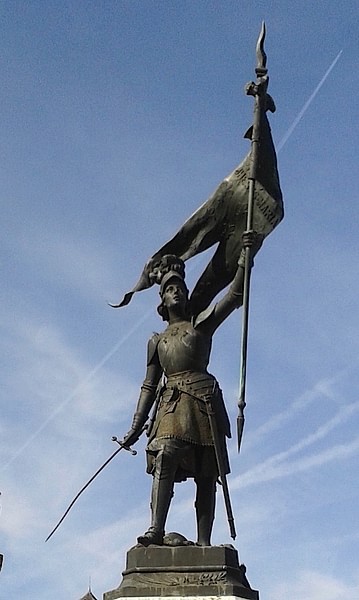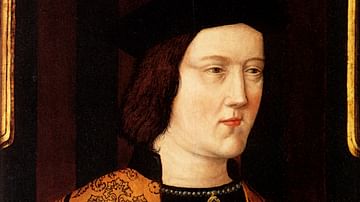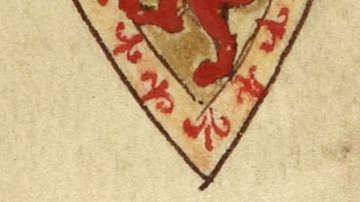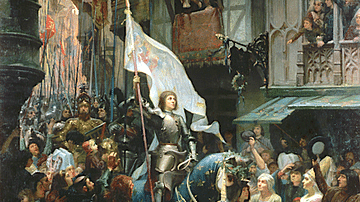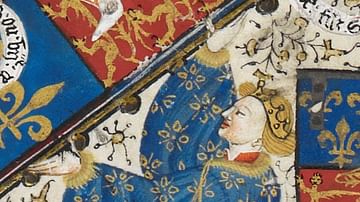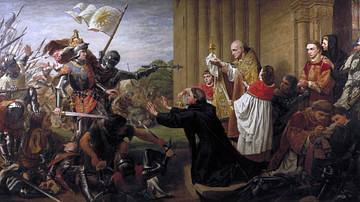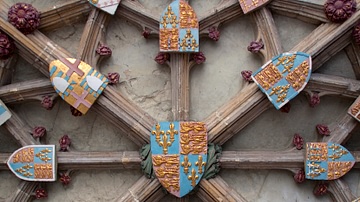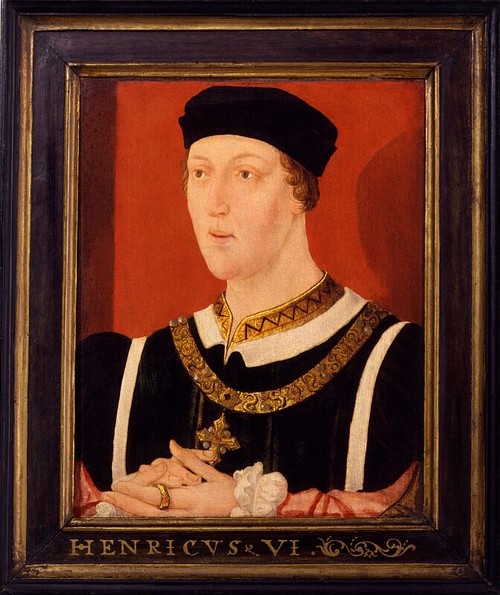
Henry VI of England ruled as king from 1422 to 1461 CE and again from 1470 to 1471 CE. Succeeding his father Henry V of England (r. 1413-1422 CE), Henry VI was crowned the king of France in 1431 CE but he could not prevent a French revival led by Charles VII of France (r. 1422-1461 CE) and such figures as Joan of Arc (c. 1412-1431 CE). The Hundred Years' War (1337-1453 CE) was ultimately lost and with it all England's territory in France except Calais. Back in England, the king's weakness of character and mind, and the intense rivalry between his barons led to the conflict known as the Wars of the Roses (1455-1487 CE) between the rival houses of Lancaster and York. After an episode of insanity, Henry VI had, in effect, a regent, Richard, the Duke of York in 1454 CE. Despite military victories by Henry's wife, Queen Margaret, the king was ultimately deposed by Richard's son Edward in 1461 CE. Henry would make a brief return to the throne in 1470 CE before Edward, now Edward IV of England (1461-1470 & 1471-1483 CE), was once more victorious on the battlefield and able to declare himself king for a second time. Henry was then murdered in the Tower of London in May 1471 CE.
Succession
Henry was born on 6 December 1421 CE in Windsor Castle, the son of Henry V of England and Catherine of Valois (l. 1401 - c. 1437 CE), the daughter of Charles VI of France. The reign of Henry's father was short but brilliant. Pressing his claim to the French throne, which had started with Edward III of England (r. 1327-1377 CE), Henry V had won a famous victory against a French army at the Battle of Agincourt in October 1415 CE and then conquered Normandy between 1417 and 1419 CE. This was to be the peak of English fortunes during the on-off conflict between the two countries known to history as the Hundred Years' War. The victories allowed Henry V to sign the 1420 CE treaty of Troyes with Charles VI of France (r. 1380-1422 CE) which made Henry the French king's heir while the blood heir, the Dauphin Charles, was disinherited. All this happened while France was split between two rival factions: the Burgundians and the Armagnacs.
Henry V died, probably of dysentery on 31 August 1422 CE at Bois de Vincennes in France. The English king had missed the chance to become the king of France by less than two months as Charles VI died on 21 October 1422 CE. Prince Henry, not even one year old, became the new king of England and the youngest to hold such a title before or since. He would not receive his coronation until 6 November 1429 CE in Westminster Abbey, officially becoming Henry VI of England. In the meantime, the infant had two regents, appointed by Henry V before his death: Humphrey, Duke of Gloucester (l. 1390-1447 CE) for England and John, Duke of Bedford (l. 1389-1435 CE) for the territories in France, where, at least according to the Treaty of Troyes, he was also now the king. Another important figure was the king's great-uncle, Henry Beaufort, Bishop of Winchester. These three men and others would entangle themselves in a spiral of competition to see who could hold most power while Henry remained a minor.
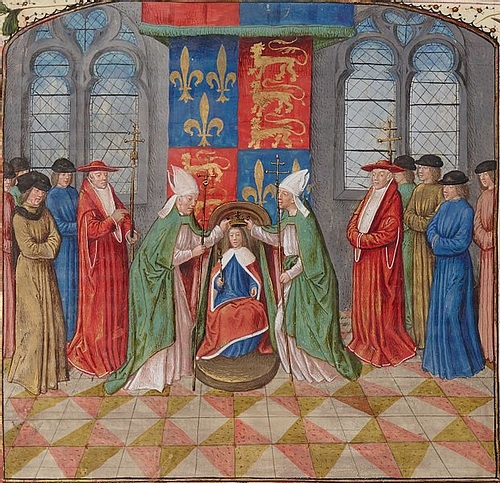
A French Revival
All the big battles of the Hundred Years' War had been won by the English but taking and then controlling French territory was another matter. To keep large armies in the field was hugely expensive and beyond the means of the English treasury to maintain. Neither was Charles, the Dauphin, prepared to sit idly and watch his inheritance be handed over to the English. Thirdly, the very character of England's king was, as he reached maturity, about to become a serious disadvantage. The young Henry was tall, well-educated, fluent in English and French, and he liked hunting, but there were serious flaws in his character. Here, the historian N. Saul summarises the common view of Henry VI by historians past and present:
It would be difficult to imagine anyone less capable than Henry VI…[he was] simple in mind. He was peace-loving, compassionate, pious to the point of prudery, and generous to his friends; but he was also naive, injudicious, and at times irrationally suspicious of those who disagreed with him. (130)
Henry and his ruling council had continued to press his family's claim for the French throne but the French fightback began in 1429 CE when an army led by Joan of Arc in 1429 CE relieved the siege of Orleans. This permitted the Dauphin to be crowned Charles VII of France in Rheims on 17 July 1429 CE in direct contravention of the Treaty of Troyes. In response, Henry had himself crowned as Henry II of France in the cathedral of Notre-Dame de Paris on 16 December 1431 CE, although loyalists to Charles VII disputed his right to do so. Henry returned to England in February 1432 CE, and he would never set foot in France again.
The fortunes of the Hundred Years' War briefly swung back in favour of the English during the early 1430s CE. Sir John Talbot (1384-1453 CE), the great medieval knight known as the 'English Achilles', won many victories thanks to his aggressive tactics and surprise attacks. In 1434-5 CE Talbot orchestrated the successful defence of English-held Paris against a French army. In January 1436 CE, while defending Rouen, Talbot launched one of his famous surprise attacks and routed a much larger French army at the Battle of Ry. However, the year before, in 1435 CE, the English had crucially lost the support of their allies the Burgundians who joined with Charles VII, by the Treaty of Arras, to end the French civil war.
In 1436 CE Henry made Sir John Talbot the Constable of France but it was also the year that Paris was lost. In February 1437 CE Talbot added to his now-legendary reputation by ordering his men to march across ice at dawn and take Pontoise while the garrison there were still feeling the aftereffects of their Shrove Tuesday celebrations the night before. Talbot won yet another victory against high odds in 1439 CE, defeating a French army led by Constable Richemont. The Fates caught up with the great knight eventually, and he was killed at the Battle of Castillon in July 1453 CE.
Consequences of Defeat
Meanwhile, the English Parliament and nobles were concerned at the huge cost of the war and the distinct lack of territorial gains. Henry VI was now ruling alone without his regents, but his aversion to warfare proved unpopular and his choice of associates even more so, especially William de la Pole, the Earl of Suffolk. The earl did, however, negotiate a five-year truce with France from 1444 CE. The price to pay for peace was the loss of Maine and, on 22 April 1445 CE, the marriage of Henry to Margaret of Anjou (d. 1482 CE), niece of Charles VII. As both actions failed to end the war, Henry's popularity sank even lower as pro-war nobles resented his capitulation and anti-war nobles lamented the continuance of a seemingly never-ending and costly war. The obvious influence of the queen on her weak-willed husband was yet another bone of contention amongst the court officials.
There was even a rebellion by commoners and local dignitaries led by the former soldier Jack Cade in 1450 CE which called for the removal of certain corrupt and inept court officials, and a return to law and order in the southeast. The message was that Henry was neglecting the necessities of everyday government even if the rebellion fizzled out after causing much destruction in London. At least, in 1440-41 CE, Henry had found time to create two famous institutions of education: Eton College, Berkshire, and King's College, Cambridge. The king funded impoverished scholars and poor commoners who could study first at Eton and then move on to King's College. In 1448 CE Margaret founded Queens' College in Cambridge.
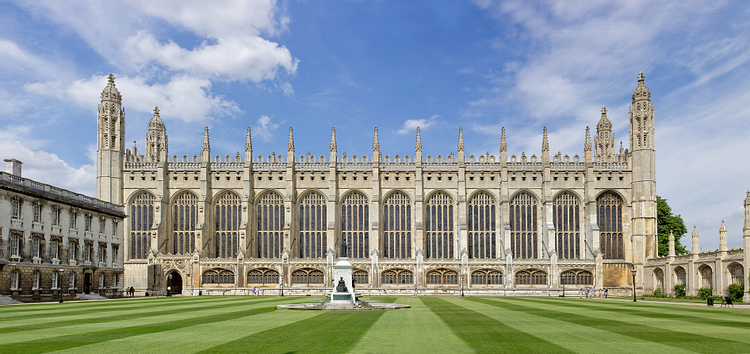
Things got even worse in France when the Earl of Suffolk invaded Brittany but only succeeded in losing control of Normandy in 1450 CE. The Earl was executed for his failures, but his replacement, Edmund Beaufort, the Earl of Somerset could not turn things around and he lost Rouen. France was too rich in men and resources while England was bankrupt and led by a king with no appetite for conflict. In 1453 CE even Gascony, which the English Crown had held for three centuries, was lost and with it the Hundred Years' War. The only French territory still in Henry's hands was Calais and just as one war ended, another was about to begin.
Wars of the Roses
In 1453 CE, on top of the defeats in France, or perhaps because of them, Henry suffered his first bout of insanity. The episode lasted 17 months during which the king understood nothing of what was said to him or even recognised anybody. The condition may have been inherited from his maternal grandfather Charles VI of France. As a result of the king's incapacity, his poor record in the war with France, and the corruption in the royal court, Richard, the Duke of York (1411-1460 CE) was made the Protector of the Realm in March 1454 CE. The Duke and the Earl of Somerset were soon at odds as each tried to get themselves nominated as Henry's heir, and this was the start of what became known as the Wars of the Roses (1455-1487 CE). The Duke of York was the great-grandson of Edward III and the nephew of the Earl of March who himself had claimed he was the legitimate heir to Richard II of England (r. 1377-1399 CE). The Earl of Somerset was also a descendant of Edward III but through that king's son John of Gaunt, father of Henry IV of England (r. 1399-1413 CE), first ruler of the House of Lancaster.
The name the 'Wars of the Roses' was applied to this rivalry by the novelist Sir Walter Scott (1771-1832 CE) after the later badges of the two families (neither of which were actually the favoured liveries in the mid-15th century CE): a white rose for York and a red rose for Lancaster (who supported Henry VI). The division was a little more complex than merely these two families as each one garnered allies amongst England's other noble families, loyalties often being decided because Henry VI had unwisely personally involved himself with disputes between them. Consequently, the war raged between two wide groups known as the 'Yorkists' and the 'Lancastrians'. However, the wars really only involved the nobility and their retainers and not the wider populace with many of the battles being better described as skirmishes.
Richard, Duke of York
In 1455 CE the Duke of York imprisoned the Earl of Somerset in the Tower of London but he was later released by a somewhat-recovered king Henry. Somerset was then killed at the Battle of St. Albans on 22 May 1455 CE by an army led by an outraged Duke Richard. Even the king was struck by an arrow in the neck during the battle and only just fled the scene. It was a mere skirmish but it was the first battle of the Wars of the Roses.
Richard, realising the king could easily be manipulated, then swore loyalty to Henry who managed, on 25 March 1458 CE ('Loveday') to reconcile the Yorkists and Lancastrians and even oblige them to walk hand-in-hand in a procession in London. However, the peace did not last long and Richard still faced a formidable obstacle to his ambitions in the form of the queen. Queen Margaret hated Richard so intensely she even led an army against the duke, defeating him at his headquarters in Ludlow at the Battle of Ludford Bridge on 12 October 1459 CE. The Duke of York fled to Ireland while Parliament, the 1459 CE 'Parliament of Devils', identified him as a traitor and disinherited his heirs.
Henry Deposed
In 1460 CE the fortunes were reversed, and a Yorkist army led by Richard Neville, the Earl of Warwick (1428-71 CE) and Richard's son Edward, Earl of March, defeated Queen Margaret's army at Northampton on 10 July and then captured King Henry. Richard, the Duke of York returned from Ireland and persuaded Henry, who was now in the Tower of London, to name him as the official heir to the throne, a decision ratified by the Act of Accord of 24 October. However, at the Battle of Wakefield on 30 December 1460 CE the Duke of York was killed and his army defeated by Henry VI loyalists led, once again, by the queen. Margaret ensured that Richard's head was displayed on a pike at Micklegate in York, adding a paper crown to remind everyone he had been a mere usurper. On 17 February 1461 CE another Yorkist army, led by the Earl of Warwick, was defeated at St. Albans, and Henry was rescued from his captivity.
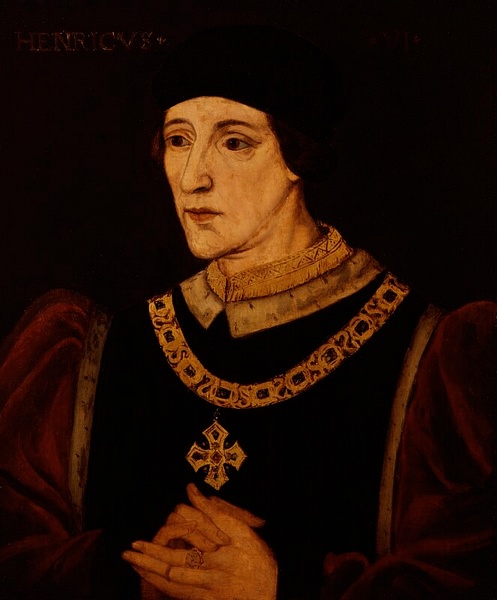
The Wars of the Roses were not over yet, though. Edward, the Duke of York's son, backed by the Earl of Warwick, was promoted as a replacement to his father and to King Henry. When Edward won the bloody Battle of Towton in March 1461 CE, the largest and longest battle in English history, this is indeed what transpired. Henry VI was deposed, and he, Queen Margaret, and their son Edward (b. 13 October 1453 CE) all fled to Scotland. Edward of York, just 19 years of age, was crowned Edward IV of England at Westminster Abbey on 28 June 1461 CE. Even this was still not the end of the civil war, merely a pause.
Reinstated - The 'Readeption'
While Queen Margaret and Prince Edward made it from Scotland to the greater safety of France, Henry VI was captured in Lancashire in July 1465 CE and imprisoned in the Tower of London again, where he was at least allowed to keep his pet dog and sparrow. There was to be another twist in the Roses War yet. When the Earl of Warwick and King Edward quarrelled over the latter's marriage to Elizabeth Woodville, Warwick joined forces with Queen Margaret and defeated King Edward's army at Northampton in the Battle of Edgecote Moor (26 July 1469 CE). Warwick imprisoned Edward IV in his castle at Middleham, but Edward managed to escape to Burgundy.
Meanwhile, Henry VI was briefly reinstated as king on 11 April 1470 CE (the 'Readeption') and he had his second English coronation, and third overall, in October of that year, this time in Saint Paul's Cathedral. Edward IV was not to be deprived, though, and, backed by an Anglo-Dutch army, he won the Battle of Barnet on 14 April 1471 CE against his ex-ally Warwick. The battle was the first in England to see both sides use artillery as a major weapon. With Warwick killed in the aftermath of Barnet, and Henry's only son killed at the Battle of Tewkesbury on 4 May 1471 CE, Edward was back on the throne.
Death & Successors
Henry, deposed for a second time, also found himself a prisoner yet again. A few weeks later, on 21 May 1471 CE, the ex-king, now aged 49, was stabbed to death in the Tower of London according to traditional accounts, dead from 'displeasure and melancholy' according to King Edward's official announcement, and from a bashed skull according to a 1910 CE forensic examination. The dead king's body was put on display for any doubters to see and then buried at Chertsey Abbey and later moved to Windsor Castle. Queen Margaret was imprisoned but was eventually released on payment of a ransom by her father the King of Sicily, and she lived the rest of her days in her native France.
Edward IV would reign until his death in 1483 CE, after which his son Edward V of England briefly became king from April to June of that year. Edward V was killed even before he had a chance to be crowned, most likely by his uncle Richard, the Duke of Gloucester in the Tower of London along with his younger brother Richard. Curiously, the Duke of Gloucester had been on duty in the Tower of London the night of Henry VI's murder. The Duke of Gloucester made himself king, Richard III (r. 1483-1485 CE), and won a place in history as one of the most despised of all English monarchs. The Wars of the Roses rumbled on and Richard was killed at the Battle of Bosworth Field in August 1485 CE. The victorious Henry Tudor of the House of Lancaster then became king Henry VII of England (r. 1485-1509 CE) and, marrying Elizabeth of York, daughter of Edward IV in 1486 CE, the two rival houses were finally united and a new one created: the Tudors.
